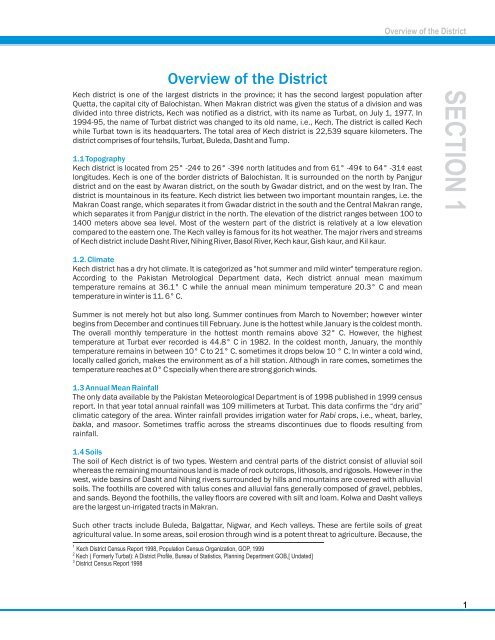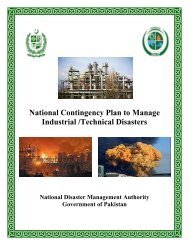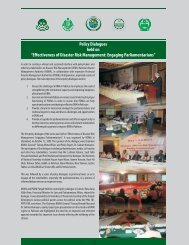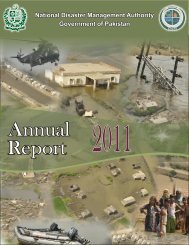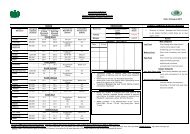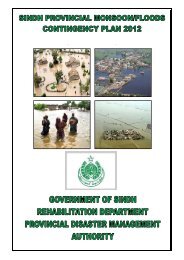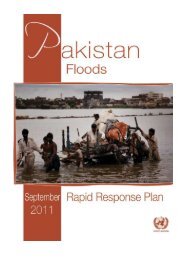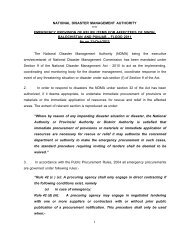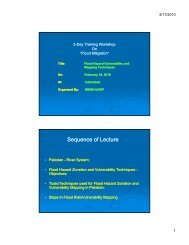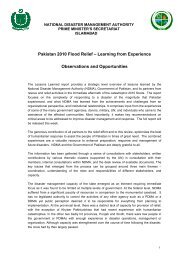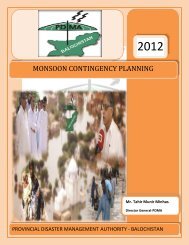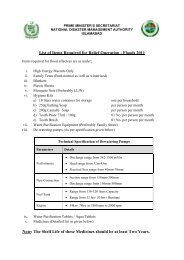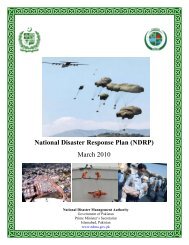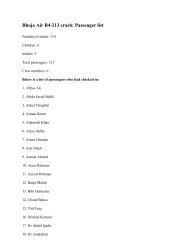District Disaster Management Plan District Kech, Balochistan - NDMA
District Disaster Management Plan District Kech, Balochistan - NDMA
District Disaster Management Plan District Kech, Balochistan - NDMA
You also want an ePaper? Increase the reach of your titles
YUMPU automatically turns print PDFs into web optimized ePapers that Google loves.
Overview of the <strong>District</strong><br />
Overview of the <strong>District</strong><br />
<strong>Kech</strong> district is one of the largest districts in the province; it has the second largest population after<br />
Quetta, the capital city of <strong>Balochistan</strong>. When Makran district was given the status of a division and was<br />
divided into three districts, <strong>Kech</strong> was notified as a district, with its name as Turbat, on July 1, 1977. In<br />
1994-95, the name of Turbat district was changed to its old name, i.e., <strong>Kech</strong>. The district is called <strong>Kech</strong><br />
while Turbat town is its headquarters. The total area of <strong>Kech</strong> district is 22,539 square kilometers. The<br />
district comprises of four tehsils, Turbat, Buleda, Dasht and Tump.<br />
1.1 Topography<br />
<strong>Kech</strong> district is located from 25° -24¢ to 26° -39¢ north latitudes and from 61° -49¢ to 64° -31¢ east<br />
longitudes. <strong>Kech</strong> is one of the border districts of <strong>Balochistan</strong>. It is surrounded on the north by Panjgur<br />
district and on the east by Awaran district, on the south by Gwadar district, and on the west by Iran. The<br />
district is mountainous in its feature. <strong>Kech</strong> district lies between two important mountain ranges, i.e. the<br />
Makran Coast range, which separates it from Gwadar district in the south and the Central Makran range,<br />
which separates it from Panjgur district in the north. The elevation of the district ranges between 100 to<br />
1400 meters above sea level. Most of the western part of the district is relatively at a low elevation<br />
compared to the eastern one. The <strong>Kech</strong> valley is famous for its hot weather. The major rivers and streams<br />
of <strong>Kech</strong> district include Dasht River, Nihing River, Basol River, <strong>Kech</strong> kaur, Gish kaur, and Kil kaur.<br />
SECTION 1<br />
1.2. Climate<br />
<strong>Kech</strong> district has a dry hot climate. It is categorized as "hot summer and mild winter" temperature region.<br />
According to the Pakistan Metrological Department data, <strong>Kech</strong> district annual mean maximum<br />
temperature remains at 36.1° C while the annual mean minimum temperature 20.3° C and mean<br />
temperature in winter is 11. 6° C.<br />
Summer is not merely hot but also long. Summer continues from March to November; however winter<br />
begins from December and continues till February. June is the hottest while January is the coldest month.<br />
The overall monthly temperature in the hottest month remains above 32° C. However, the highest<br />
temperature at Turbat ever recorded is 44.8° C in 1982. In the coldest month, January, the monthly<br />
temperature remains in between 10° C to 21° C. sometimes it drops below 10 ° C. In winter a cold wind,<br />
locally called gorich, makes the environment as of a hill station. Although in rare comes, sometimes the<br />
temperature reaches at 0° C specially when there are strong gorich winds.<br />
1.3 Annual Mean Rainfall<br />
The only data available by the Pakistan Meteorological Department is of 1998 published in 1999 census<br />
report. In that year total annual rainfall was 109 millimeters at Turbat. This data confirms the “dry arid”<br />
climatic category of the area. Winter rainfall provides irrigation water for Rabi crops, i.e., wheat, barley,<br />
bakla, and masoor. Sometimes traffic across the streams discontinues due to floods resulting from<br />
rainfall.<br />
1.4 Soils<br />
The soil of <strong>Kech</strong> district is of two types. Western and central parts of the district consist of alluvial soil<br />
whereas the remaining mountainous land is made of rock outcrops, lithosols, and rigosols. However in the<br />
west, wide basins of Dasht and Nihing rivers surrounded by hills and mountains are covered with alluvial<br />
soils. The foothills are covered with talus cones and alluvial fans generally composed of gravel, pebbles,<br />
and sands. Beyond the foothills, the valley floors are covered with silt and loam. Kolwa and Dasht valleys<br />
are the largest un-irrigated tracts in Makran.<br />
Such other tracts include Buleda, Balgattar, Nigwar, and <strong>Kech</strong> valleys. These are fertile soils of great<br />
agricultural value. In some areas, soil erosion through wind is a potent threat to agriculture. Because, the<br />
1 <strong>Kech</strong> <strong>District</strong> Census Report 1998, Population Census Organization, GOP, 1999<br />
2 <strong>Kech</strong> ( Formerly Turbat): A <strong>District</strong> Profile, Bureau of Statistics, <strong>Plan</strong>ning Department GOB,[ Undated]<br />
3 <strong>District</strong> Census Report 1998<br />
1


